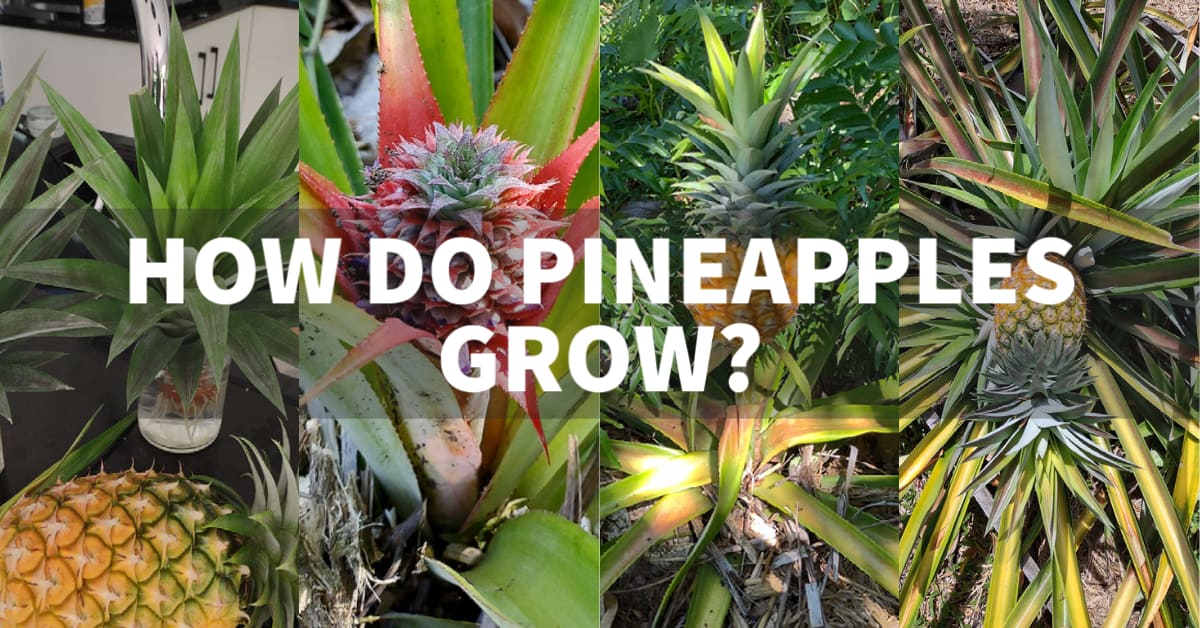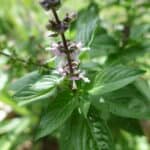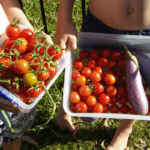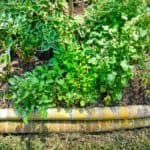This post may contain affiliate links.
Pineapples are sweet, delicious, golden yellow fruits from tropical regions. If you love to eat pineapple but have only seen it in tins or at the grocery store, this post explains how do pineapples grow, and how to grow pineapples. Pineapples are farmed commercially in our region, field after field of rows of spiky pineapple plants. We also grow abundant, huge sweet pineapples in our garden at home. This post explains how pineapples grow, with some tips on pineapple propagation from tops and pups.
This Is How Pineapples Grow!

Pineapples are fruits. The pineapple plant flowers on a short sturdy stem. As this flower becomes pollinated the fruit, the pineapple, forms in the usual way. Once it reaches its full size, the fruit eventually changes from dark olive green, to a golden yellow.
When the fruit shows some yellow it should be ready to harvest. Leave it too long, and it will start to ferment and break down. Most pineapples you see in supermarkets will be green, they’re not ripe.
You haven’t tasted pineapple unless you have one golden yellow picked fresh from your garden. They are delicious!
Do Pineapples Grow on Trees?
No, pineapples do not grow on trees. There is no such thing as a pineapple tree.
Pineapple plants grow close to the ground and the spiky plant forms a rosette of sharp leaves. The pineapple forms from the centre.
The pineapple is typically about a foot from the ground, 12 inches or so. Pineapples are flowering plants this is how they reproduce.
Pineapple Flowers
The first thing to look for with your pineapple plants, is the start of a new flower forming at the centre of the crown of spiky leaves. You may notice the “throat” of the pineapple plant showing increased red pigmentation before the flower itself becomes visible.

When To Harvest a Pineapple?
How do you know if a pineapple is right? I’d generally wait for the majority of the pineapple to be yellow to golden yellow. If the majority of the pineapple fruit is dark green, it won’t be as sweet as it could be.

If the pineapple is lying in direct sun, you may find that the part of the fruit that gets the most intense sunlight will change from yellow to brown. This part won’t be good to eat, it can ferment. So best to pick your pineapples before this happens.

You’ll also notice that the mature pineapples will start to topple over on their stems. Young, unripe, pineapples usually stand erect. Ripe and near-ripe pineapples fall over to lie more on their sides.
Smaller pineapples are more likely to remain upright when ripe.
If you’re looking to buy a ripe pineapple in a supermarket, look for a good yellow to gold colour, a pleasant pineapple smell, fresh-looking green tops, and no soft or squishy parts. You’ll probably notice that most supermarket pineapples will be under-ripe.
I’ve never had a store-bought pineapple that tastes as good as homegrown! The colour, flavour, and scent have always been inferior. They’re also likely to have been exposed to pesticides and herbicides, unfortunately.
This is one of the great benefits of growing your own food, you know what’s been used on and near it.
Are Pineapples Easy To Grow?
Pineapples are actually one of the easiest fruits, and easiest plants, that grow in the tropics. We have no issues with pests and they seem to do OK in conditions such as dry winters and very wet summers.
You can see pineapples growing in the wild or on pineapple farms in countries such as Malaysia, Sri Lanka, and Australia. Maybe even in Florida! or Hawaii!
In fact, the little green frogs that often take up residence inside our pineapple’s spiky leaves, are sure to keep the garden bugs down.
I’ve never seen any bug eating a pineapple plant! They also deter certain birds, even chickens and bush fowl.
You will notice that your pineapples will be bigger in rich soil, with plenty of water. In poor soil with low water, they will be smaller.
Also, pineapples set fruit at different times of year, in our experience. The fruit that sets, and grows in the wet season, to be ready around October-November, has always been bigger than fruit that sets in the dry season, our winter.
To give your pineapple plants the best chance of growing huge, delicious pineapples, work on enriching their soil with organic material and nutrients. Vermicompost, or any home-made compost or rotted manure is great for this.
But I always say that if the conditions aren’t perfect, try to grow them anyway! A small pineapple is better than no pineapple!
How Do Pineapples Grow in Poor Soil or Bad Conditions?

We have successfully grown pineapples in bad soil, clay soil, and soil that’s too dry. They have grown and produced pineapples, but they’ve been small. Find a good spot with rich soil, good water retention, and plenty of sunshine to grow pineapples.
The better the soil, water, and sunshine, the bigger the pineapple!
How Long Does it Take to Grow a Pineapple?
How long it takes to grow a pineapple depends on a lot of factors. Did you grow your pineapple plant from a pineapple top, slip, or pup? Is your soil good and has the weather been warm and sunny enough?
Generally, allow up to 2 years for a pineapple fruit to form on a plant grown from a pineapple top. If you’re struggling with cold, shade, or lack of nutrients, this could take even longer.
Suckers will produce pineapple fruit sooner, at around 18 months, and slips are fastest of all to bear fruit, taking about a year.
Your pineapple plants will reproduce fast, naturally, giving you many new plants and pineapples as the years pass. That first 2 year waiting period is the longest wait.
Once the flower forms you still have around 6 months to wait, before you can harvest your first home-grown pineapple, it should be the best you’ve ever tasted!
Pineapples produce fruit at various times of year so you should have a succession of fruit, rather than a glut.
What To Do With Home-Grown Pineapple?

- You need a mandolin to cut pineapple this thinly. Even if you happen to be a professional chef, as my husband is. It’s also great for kraut and green papaya salad. See ours here. We’re very happy with this brand and own multiple pieces of kitchen equipment from this range.
- A dehydrator is your best friend if you grow herbs, fruits, or vegetables. See one here. Again, a solid choice. We use it a lot for herbs and teas.
Pineapples can be huge, and if you have several fruit all ripening within days of each other, you may have more sweet, juicy, pineapple than you can eat fresh. What can you do with excess pineapple?
Here are some things we’ve done to store, preserve, or utilise pineapple.
- pineapple upside-down cake is a favourite with my kids!
- pineapple jam is delious.
- Thinly sliced pineapple, cut using a mandolin, like this, can go in your dehydrator for future delicious fruit snacks.










Thanks
Does pineapple require sandy spoil
Also , does saline soil affect it’s performance
If you have very wet conditions sandy soil may help with drainage, but it’s certainly not “required”. Mine grow great in quite heavy clay, but they are raised in mounds so their feet can stay dry-ish. Salt… pineapples are quite good at tolerating a little salinity in the soil.
My pineapple plant is falling over…and leaves are turning yellow. Wat should I do? I’ve read to add iron and zinc….. should I??
It could be any number of causes. Something eating the roots? You forgot to water it? Too cold? Too wet and it’s rotting? Or, as you said, nutrient deficiencies. I’d try a good all-round fertiliser, some compost tea, worm castings etc, rather than worrying about specific elements just yet. But it sounds like it’s dying, if the leaves are soft and yellow rather than hard and slightly discoloured, it’s likely too late. Stick your finger in the soil about an inch to see if it’s wet or dry. If it’s soggy it won’t be happy. There are also problems all around the world with bought soil (and mulch) being contaminated with herbicites, or just very poor quality. Could be that too.